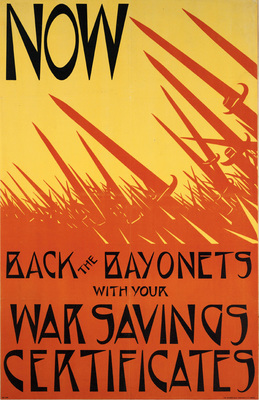
Description
The work of British Futurist painter C. R. W. Nevinson came to public prominence during the Great War. Having served in both the Friends Ambulance Unit and the Royal Army Medical Corps, he was appointed the official war artist by the British Department of Information in 1917. In this capacity, he spent four weeks on the Western Front, deriving material for an exhibition of his work in London. To advertise his exhibition, Nevinson created a lithographic poster filled with dozens of red, piercing bayonets positioned against a bright yellow background. The black, angular letter form echoes the sharpness of the weapons. Although highly abstracted and stylized, the design effectively conveys the brutality of war. This poster was so popular that the National War Savings Committee appropriated the image for their 1918 campaign. During World War I, bayonets were still used in face-to-face combat and were part of an arsenal of both traditional and modern weapons: rifles, poison gases, tanks, cannons, and bombs. In All Quiet on the Western Front, the narrator complains about the inefficiency of the bayonet, [it] frequently jams on the thrust and then a man has to kick hard on the other fellows belly to pull it out again; and then he may easily get one himself.
Details
- Work Date:
- 1918